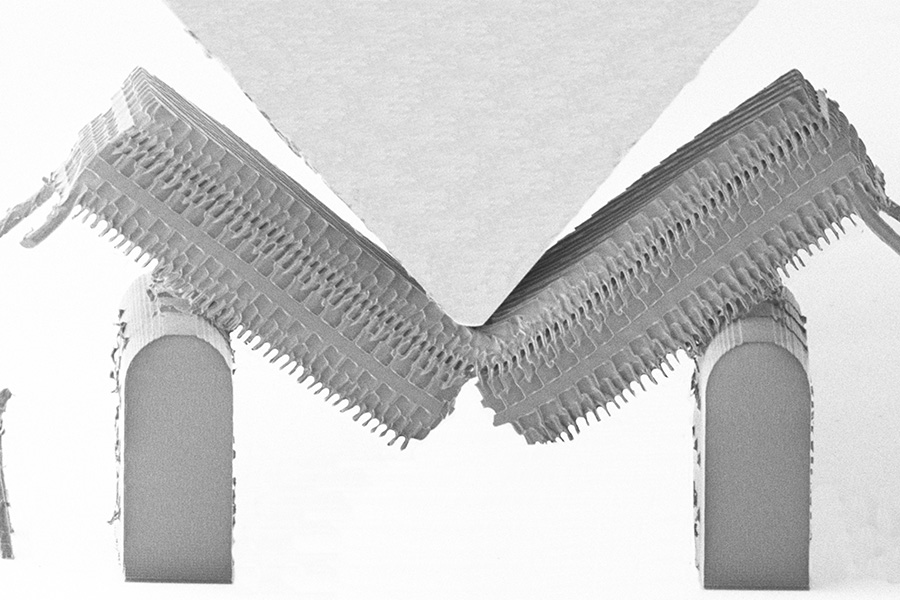A beetle shell might look like solid armor to us, but it’s actually composed of tiny fibers woven together in complex structures. These nanofibers that comprise many natural materials from shell to skin to cartilage are surprisingly tough and are able to handle force without fracturing.

UW researchers tested the twisted nanostructures they created by applying very small loads with nanometer precision (shown here) and visualizing when cracks began to form. From the obtained data, the researchers measured the growth of cracks and thus calculated a material toughness.
Inspired by natural nanostructured materials, the Meza Research Group recently investigated how these tiny structures make materials resistant to breaking. The team’s research sheds light on how methods like reducing fiber size and increasing fiber twist can improve durability.
Using additively manufactured polymer nanofibers as a building block, the lab, led by ME Assistant Professor Lucas Meza, creates nanostructured materials that are about 400 nanometers wide, similar to the smallest features found in natural materials. In their most recent work, they used these polymer nanofibers to create twisted “Bouligand'' structures, a common twisted-fiber motif found in arthropod shells. The final test samples they made were about 80 micrometers wide – similar to the width of a piece of paper.
“The novelty of our work is in the scale at which we can study toughness. We expect tiny, lightweight materials to be less tough than denser materials,” Meza says. “Instead, we see nanostructured materials can be 50% lighter while maintaining their toughness.”
The Meza group recently published a paper about the lab’s findings, “Toughness amplification via controlled nanostructure in lightweight nano-Bouligand materials,” in the journal Small. Zainab Patel, a Ph.D. student in materials science and engineering, led the study, and ME Ph.D. student Kush Dwivedi also contributed to the research.
To make their materials, the researchers used two-photon lithography, an additive manufacturing technique that shines a laser into a photosensitive polymer to cure it. By tracing the laser around in space, they can create tiny beams with fibers that are either joined together or separate. They designed samples with layers of these nanofibers that have different twists and spacings, creating the desired spiraling Bouligand pattern found in nature.
To test these materials, the researchers placed a nanoindenter, an instrument that measures the mechanical properties of tiny materials, inside a scanning electron microscope to both apply very small loads with nanometer precision and to visualize when cracks began to form. From the obtained load displacement data, the researchers can measure the growth of cracks and thus calculate a material toughness.
“Nanomaterials are all around us. By understanding how fracture happens at the smallest length scales, we can develop new ways to make tougher, more resilient materials at any scale.”
The researchers discovered two methods for toughening the materials: isolating the fibers and twisting the fibers. They found isolated nanofibers had greater ductility, or ability to stretch further before breaking, meaning they could absorb more energy to prevent cracks from growing. Twisting the nanofibers at different angles creates different soft and stiff regions between the layers. Because of this Bouligand-style architecture, cracks then get “stuck” between the soft and stiff layers and have more difficulty progressing, making the material tougher.
These discoveries have implications for the printing of more resilient additively manufactured materials, and for objects created using nanomaterials, such as composites and electronics. For example, nanofibers could be used to make tougher clothing, or incorporated into carbon fiber composites to make them more resistant to fracture and delamination, or layer separation.
“Nanomaterials are all around us, whether it’s in the beetles we see outside our window or the transistors that make up our computer chips,” Meza says. “By understanding how fracture happens at the smallest length scales, we can develop new ways to make tougher, more resilient materials at any scale.”
Originally published May 22, 2023